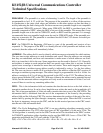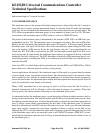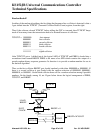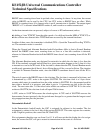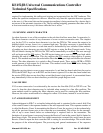
KS152JB Universal Communications Controller
Technical Specifications
Kawasaki LSI USA, Inc. Page 46 of 120 Ver. 0.9 KS152JB2
BKOFF starts counting down from its preload value, counting slot times. At any time, the current
value in BKOFF can be read by the CPU, but CPU writes to BKOFF have no effect. While
BKOFF is counting down, if its current value is not 0, transmission is disabled. The output signal
“BKOFF = 0” is asserted when BKOFF reaches 0, and is used to re-enable transmission.
At that time transmission can proceed, subject of course to IFS enforcement, unless:
☛ shifting a 1 into TCDCNT from the right caused a 1 to shift out from the MSB of TCDCNT, or
☛ the collision was detected after TFIFO had been accessed by the transmit hardware.
In either of these cases, the transmitter is disabled (TEN = 0) and the Transmit Error flag TCBT is
set. The automatic restart is canceled.
Where the Normal and Alternate Random backoff algorithms differ is that in Normal Random
backoff the BKOFF timer starts counting down as soon as a line idle condition is detected,
whereas in Alternate Random backoff the BKOFF timer doesn’t start counting down till the IFS
expires.
The Alternate Random mode was designed for networks in which the slot time is less than the
IFS. If the randomly assigned backoff time for a given transmitter happens to be 0, then it is free
to transmit as soon as the IFS ends. If the slot time is shorter than the IFS, Normal Random mode
would nearly guarantee that if there’s first collision there will be a second collision. The situation
is avoided in Alternate Random mode, since the BKOFF countdown doesn’t start till the IFS is
over.
The unit of count to the BKOFF timer is the slot time. The slot time is measured in bit-times, and
is determined by a CPU write to the register SLOTTM. The slot time clock is a 1-byte down-
counter which starts its countdown from the value written to SLOTTM. It is decremented each bit
time when a backoff is in progress, and when it gets to 1 it generates one tick in the slot time
clock. The next state after 1 is the reload value which was written to SLOTTM. If 0 is the value
written to SLOTTM, the slot time clock will equal 256 bit times.
A CPU writes to SLOTTM accesses the reload register. A CPU read of SLOTTM accesses the
downcounter. In most protocols, the slot period must be equal to or greater than the longest round
trip propagation time plus the jam time.
Deterministic Backoff
In the Deterministic backoff mode, the GSC is assigned (in software) a slot number. The slot
assignment is written to the low 6 bits of the register MYSLOT. This same register also contains,
in the 2 high bit positions, the control bits DCJ and DCR.
Slot assignments therefore can run from 0 to 63. It will turn out that the higher the slot assign-
ment, the sooner the GSC will get to restart its transmission in the event of a collision.



